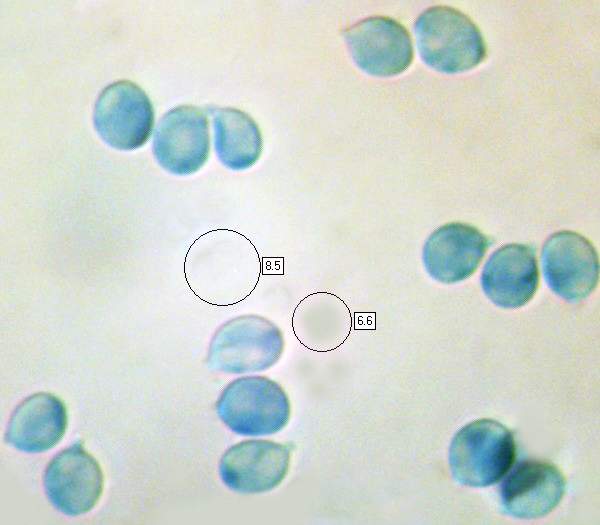Tremella aurantia Schwein. [Syn. Naematelia aurantia (Schwein.) Burt]
Phylum: Basidiomycota - Class: Tremellomycetes (insertae sedis) - Order: Tremellales - Family: Tremellaceae
Distribution - Taxonomic History - Etymology - Identification - Culinary Notes - Reference Sources
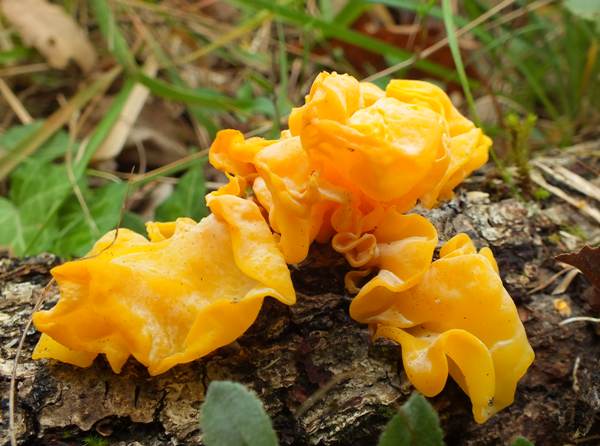
Tremella aurantia and its lookalike Tremella mesenterica - the latter bearing the common name Yellow Brain Fungus - are mainly seen in winter, when their multi-folded jelly-like fruitbodies appear on fallen wood of broadleaf trees (both species) and on standing deadwood parts of living trees (in the case of Tremella mesenterica). In dry weather these colourful fungi lose their lustre and become hard orange crusts or brackets, in which state they are much more difficult to spot. When it rains the fruitbodies rehydrate and turn yellow again.
Late summer and autumn are the best times to look for Tremella aurantia, which is capable of both sexual and asexual reproduction: it propagates not only via basidiospores but also by producing conidiospores.
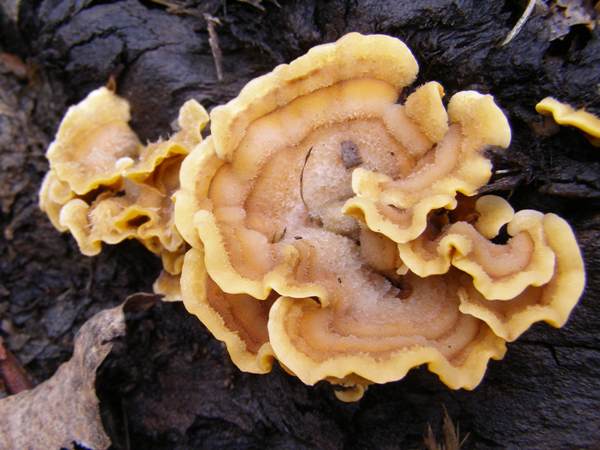
Above: Hairy Curtain Crust fungus Stereum hirsutum is a conspicuous and very common species whose fruitbodies can be found throughout the year; this is the fungal host upon whose mycelium the jelly fungus Tremella aurantia feeds.
Like the closely-related Yellow Brain fungus Tremella mesenterica, Tremella aurantia grows on dead wood that has been attacked by wood-rotting fungi, but in this instance not of the Peniophora genus but Stereum, and in particular the Hairy Curtain Crust Stereum hirsutum. One of the easiest ways of determining which of these macroscopically very similar fungi you have found is to look for evidence of the type of crust fungus it is feeding upon. Unfortunately, once the Tremella fruitbody has developed it often covers most and sometimes all of the crust fungus fruitbody, but of course the Tremella carries on feeding upon the mycelium of its host within the dead wood.
Distribution
In Britain this attractive jelly fungus is recorded only rarely, mainly in southern England and eastern Wales; however, it seems likely that in the past other collections would have been wrongly recorded as Tremella mesenterica.
Tremella aurantia has been found in many other European countries from Norway down to Portugal, and so it seems very likely that this species might also occur in Scotland. In North America, where it is commonly called Golden Ear, Tremella aurantia is reported to be a widespread and abundant jelly fungus.
Taxonomic history
This jelly fungus was originally described in 1822 by American mycologist Lewis David von Schweinitz (1780 - 1834), who named it Tremella aurantia, by which name many mycologists still refer to it today. In 1921, American mycologist Edward Angus Burt (1859–1939) transferred this species to a new genus, Naematelia, and its currently recommended scientific name is Naematelia aurantia (Schwein.) Burt.
Etymology
Tremella, the generic name means trembling - a reference to the wobbly-jelly-like structure of fungi within this grouping, The specific epithet aurantia means orange - a reference to the fruitbody colour.
Identification guide
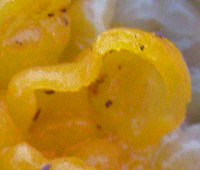 |
FruitbodyUsually golden yellow and gelatinous when damp, turning orange and shriveling to a tiny fraction of its former size during very dry weather; initially disc-like, the fruitbody soon develops irregular convoluted folds with rounded margins. Individual fruitbodies grow to between 2 and 10cm across. |
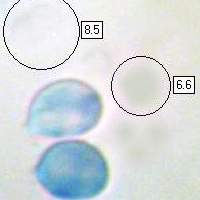 |
SporesSubglobose to broadly ovoid, smooth, thin-walled, 5.5-9 x 4.5-7µm, inamyloid; with a hilar appendage.
Spore colourWhite. |
Odour/taste |
Not distinctive. |
Habitat & Ecological role |
This jelly fungus grows on dead timber of broadleaf trees, but it is particularly common on stumps and fallen branches of oak and beech. It is not the dead timber that Tremella aurantia consumes but rather a kind of bracket or crust fungus that itself has been feeding on the wood. Tremella aurantia must therefore be - Classed as a parasitic rather than saprobic species. In Britain (and probably elsewhere) it attacks Hairy Curtain Crust Stereum hirsutum. |
Season |
This jelly-like fungus can be found throughout the year, but it is most visible in autumn and winter. |
Similar species |
Tremella mesenterica is parasitic on Peniophora crust fungi, which occur on dead hardwoods, particularly oaks. Its spores are broadly ellipsoidal. Mycologist Peter Roberts (see references, below) points out that Tremella aurantia usually has more pruinose surfaces due to a heavy coating of basidiospores and/or conidiospores) Tremella foliacea is brown and has a lobed structure. |
Culinary Notes
Some authorities say that this is an edible but very poor fungus, but being insubstantial it has no culinary value.
Reference Sources
Fascinated by Fungi, 2nd Edition, Pat O'Reilly 2016, reprinted by Coch-y-bonddu Books in 2022.
Peter Roberts (1995), British Tremella species I: Tremella aurantia & T. mesenterica. Mycologist Vol9 Issue 3.
British Mycological Society, English Names for Fungi
Dictionary of the Fungi; Paul M. Kirk, Paul F. Cannon, David W. Minter and J. A. Stalpers; CABI, 2008
Taxonomic history and synonym information on these pages is drawn from many sources but in particular from the British Mycological Society's GB Checklist of Fungi.
Fascinated by Fungi. Back by popular demand, Pat O'Reilly's best-selling 450-page hardback book is available now. The latest second edition was republished with a sparkling new cover design in September 2022 by Coch-y-Bonddu Books. Full details and copies are available from the publisher's online bookshop...

